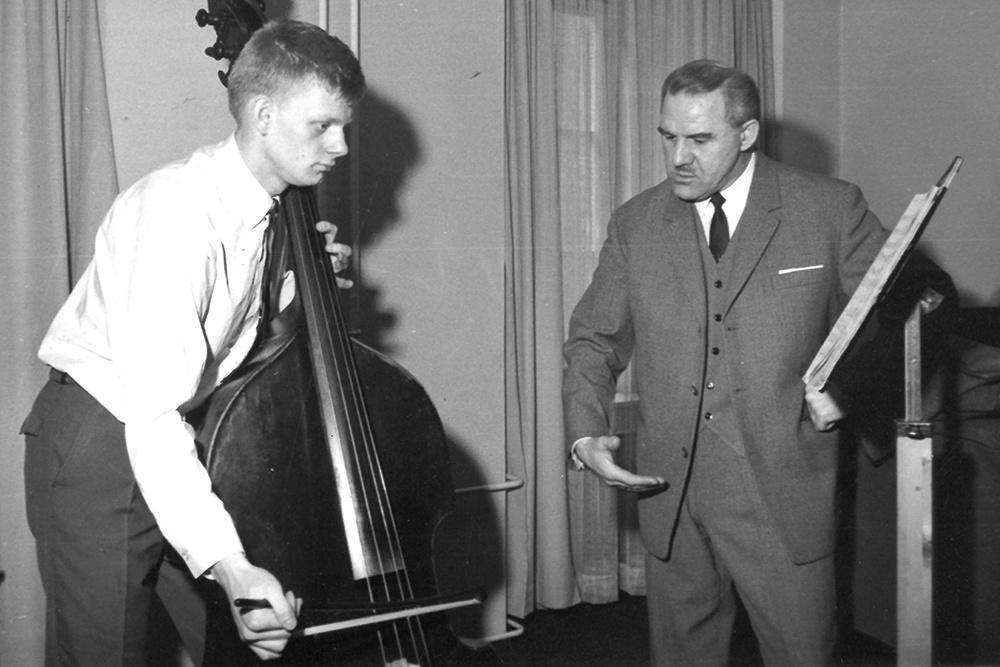Ana Valéria Poles studierte von 1982 bis 1988 bei Professor Streicher in Wien. Für das mdw-Magazin gibt sie Einblick in Streichers Leben und Wirken und versucht, seinem Musikverständnis, das er selbst gerne mit „Musizieren“ umschrieb, näherzukommen.

Ludwig Streicher, genialer Musiker und „Showman“, hat mit seinem Kontrabass die ganze Welt bereist. Er war ein Virtuose am Instrument, der die „ernste“ Welt der klassischen Musik oft mit Witz und Humor aufzulockern wusste. Streicher als Stargast in Fernsehshows, Streicher, der von der schönen Fürstin von Monaco ein Busserl als Gage verlangte… Wohl jeder, der ihn kannte, weiß die eine oder andere Anekdote aus seinem beeindruckenden Leben zu berichten. Aber Ludwig Streicher war vor allem eines: ein ernsthaft arbeitender Musiker und engagierter Lehrer. Er hat den Kontrabass als Soloinstrument etabliert, eine international beachtete Kontrabass-Klasse an der Wiener Musikhochschule (heute mdw) aufgebaut und dazu ein wegweisendes Lehrwerk verfasst.
Das Talent
Musizieren war Ludwig Streicher schon in die Wiege gelegt, denn das Gasthaus seiner Eltern im niederösterreichischen Ziersdorf war das Probelokal der örtlichen Musikkapelle und sein komponierender Vater war der Kapellmeister. Der arrangierte von der böhmischen Polka bis zur Verdi-Oper alles, was die jeweilige Besetzung gerade erlaubte. Und von ihm erhielt Ludwig den ersten Geigenunterricht. Dann folgte das Cello, und mit vierzehn Jahren wechselte er zum Kontrabass. In Wien studierte er bei den Professoren Schreinzer und Krump, beide ehemalige Schüler des bekannten Solisten Franz Simandl, der 1873 eine beachtenswerte Kontrabass-Schule publiziert hatte. Nach Abschluss des Studiums im Kriegsjahr 1940 engagierte ihn das Stadttheater Krakau als ersten Kontrabassisten. Dort erweiterte er bei einem Casals-Schüler auch seine Cellokenntnisse und wurde alternierend auch Stimmführer der Cellogruppe. 1944 endete Streichers Engagement abrupt, als ihn die deutsche Wehrmacht zum Kriegsdienst einzog. Nach russischer Gefangenschaft und einer abenteuerlichen Flucht kehrte er im Frühling 1945 zu Fuß in seinen Heimatort Ziersdorf zurück.
Der Solist
Nur mit Hilfe eines russischen Offiziers, der ihn in seinem Panzer über die beschädigten Straßen nach Wien brachte, gelangte Streicher im selben Jahr rechtzeitig zu einem Staatsopern-Probespiel, das er erfolgreich absolvierte. Bald darauf wurde er Mitglied der Wiener Philharmoniker und in den folgenden Jahren lernte er das große Opern- und Konzertrepertoire auf höchstem Niveau kennen. Streicher litt unter der damaligen Geringschätzung des Kontrabasses als Soloinstrument; kaum jemand hielt ein abendfüllendes Konzert für machbar. Erst als er den Pianisten Max Valicek kennenlernte, ermutigte ihn dieser, solistisch aufzutreten. Im April 1966 wagte er schließlich mit Valicek sein erstes Solokonzert in Wels und der Erfolg war sensationell. „Aus Wels in die Welt!“, pflegte er später gerne schmunzelnd zu sagen. Die darauf folgenden Konzertreisen führten ihn durch Europa, in den Nahen Osten, nach Amerika, Afrika, Japan, Korea und Taiwan. Er wurde zu Meisterkursen eingeladen und hatte Rundfunk- und Fernsehauftritte. Seine erste Schallplatte Musikalische Raritäten für Kontrabass nahm er 1967 auf, dabei leistete er Pionierarbeit im Bereich der Recherche und des Repertoires. Es folgten weitere Aufnahmen, herausragend wohl Ludwig Streicher spielt Bottesini, auf der er erstmals Werke des „Paganini des Kontrabasses“ auf einer Platte vereinigte. Astrid Spitznagel, die noch heute an der mdw tätig ist, wurde in späteren Jahren seine ständige Klavierbegleiterin.
Der Streicher-Stil
Streichers Spielweise entspringt einer altösterreichischen Tradition. Sie geht über Franz Simandl in direkter Linie zurück auf Wenzel Hause (1764–1847) in Prag, der schon damals die heute übliche Haltung der Greifhand propagierte. Auch Streichers Variante der „deutschen Bogenhaltung“ wurde schon von Simandl angewandt (übrigens schön zu sehen auf Max Oppenheimers Gemälde Das Orchester im Belvedere, auf dem Gustav Mahler die Wiener Philharmoniker dirigiert). Jedenfalls leistete Streichers durchdachte Bogenführung einen wesentlichen Beitrag zu seinem Erfolg. Sie gewährleistet einen organischen, kontrollierten Bewegungsablauf von der Schulter bis in die Fingerspitzen, wodurch eine klare Artikulation in den tiefen Lagen, aber auch eine weiches, volltönendes Legatospiel ermöglicht wird.
Der Lehrer
Von 1966 bis 1990 prägte Streicher den Kontrabassunterricht an der Wiener Akademie für Musik und darstellende Kunst (heute mdw) und von 1992 bis 2001 hatte er eine Gastprofessur an der Escuela Superior de Música Reina Sofía in Madrid. Dafür verfasste er 1978, also rund hundert Jahre nach Simandl, seine Schule Mein Musizieren auf dem Kontrabass. Die musikalische Grundlage des fünfbändigen Werkes bilden Volkslieder, Orchesterstellen sowie Auszüge aus der Sololiteratur. Der systematische Aufbau ermöglicht das Erarbeiten jeder Lage mittels kleiner musikalischer Übungen. Von Anfang an wird dabei auf Rhythmus, Artikulation und Dynamik Wert gelegt. Es geht darum, technische Probleme mit musikalischem Empfinden und Verstehen zu lösen. „Musik muss zuerst durchs Herz, dann ins Hirn und schließlich durch den Körper gehen, genau in dieser Reihenfolge“, so brachte Streicher sein Musikverständnis auf den Punkt. Mein Musizieren auf dem Kontrabass ist bis heute das Standardwerk einer professionellen Ausbildung am Kontrabass. Der Unterricht selbst bestand aus konsequenter Arbeit. „Tonleitern, Etüden, Orchesterstellen, Solostücke – das ist unser Programm“, so Streicher stets. Der kleine Raum im Dachgeschoss der Seilerstätte 26 war bevölkert von oft weit angereisten MusikerInnen aller Instrumentengattungen. Sie wollten diesen charismatischen Menschen erleben, der mit seinen Studierenden leidenschaftlich um jeden Ton rang, kompromisslos die musikalische Essenz jeder Phrase erarbeitete und der nebenbei und anekdotenhaft sein breites instrumentales Wissen einfließen ließ. Es wurde gelacht und auch geweint, aber schließlich erreichten Streichers Studierende ein hohes Niveau. Orchester- und Professorenstellen in der ganzen Welt sind heute mit seinen Schülern besetzt, an der mdw übernahm Josef Niederhammer 1991 seinen Lehrstuhl. Ludwig Streicher verstarb am 11. März 2003 in Wien. Das moderne Kontrabassspiel ist ohne ihn nicht denkbar. Und 2020 wäre sein hundertster Geburtstag, sollten wir den nicht feiern?
- Mehr Infos über Ludwig Streicher finden Sie unter www.ludwig-streicher.at

